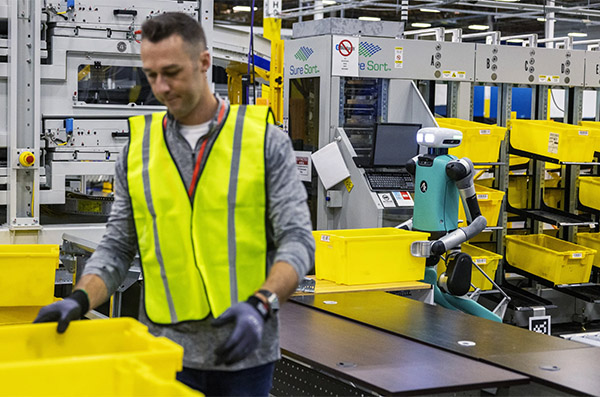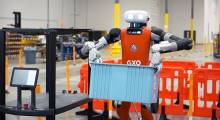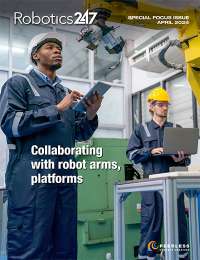Amazon.com Inc. uses many robots in addition to those it acquired with Kiva Systems a decade ago. The Seattle-based e-commerce company noted that it has more than 750,000 robots working with its employees to relieve them of repetitive tasks. Amazon today announced that it is launching a new robot to help fulfill customer orders for the upcoming holiday shopping season. It is also testing Agility Robotics' mobile manipulation system.
The new system, Sequoia, is already operating at an Amazon fulfillment center in Houston. Based on a series of research and development efforts at Amazon, Sequoia integrates multiple robots to containerize inventory into totes. It combines mobile robots, gantry systems, robotic arms, and a new ergonomic employee workstation.
“From our latest robotic arms like Sparrow and Cardinal, to our first autonomous mobile robot, Proteus, we’re excited to see the impact our technology is having in Amazon’s operations,” wrote Scott Dresser, vice president of Amazon Robotics, in a blog post. “By reimagining how we store and manage inventory at our sites, Sequoia will help us delight customers with greater speed and increased accuracy for delivery estimates, while also improving employee safety at our facilities.”
Sequoia designed to accelerate fulfillment
The new system's mobile robots transport containerized inventory directly to gantry equipment that can either restock totes or send them to an employee to pick out inventory that customers have ordered.
Dresser claimed that Sequoia enables the company to identify and store inventory up to 75% faster than it typically can today. As a result, Amazon.com said it can list items for sale more quickly, benefiting both sellers and customers.
Sequoia can also reduce the time it takes to process an order through a fulfillment center by up to 25%, the company noted. This would improve shipping predictability and increase the number of goods Amazon can offer for same-day or next-day shipping, it said.
These totes go to a new workstation designed to allow employees to do all their work in the “power zone,” between mid-thigh and mid-chest height. “With this system, employees will no longer have to regularly reach above their heads or squat down to pick customer orders, supporting our efforts to reduce the risk of injuries,” said Amazon.
Once orders are picked, the remaining inventory needs to be consolidated so that site storage can be efficiently managed. Amazon has designed its new Sparrow robot arm to tackle the repetitive task of consolidating inventory in totes so that full totes can be returned to storage.
Sparrow's integrated robots “will dramatically simplify and optimize how we store goods and help employees pick those goods in a safe way,” the company asserted. It thanked its team and partners in noting that, in 2022, recordable incident rates and lost-time incident rates were 15% and 18% lower, respectively, at Amazon Robotics sites than non-robotics sites.
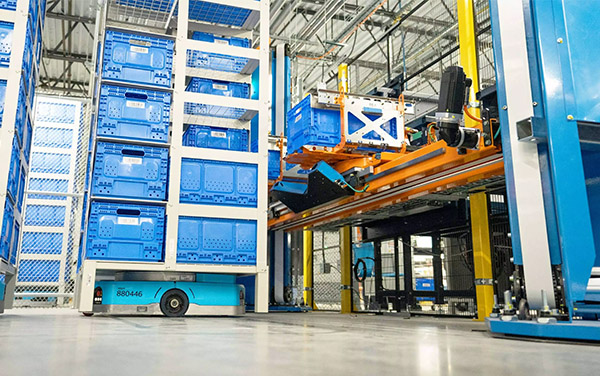
Amazon collaborates with Agility Robotics
Amazon Robotics added that it has begun testing mobile manipulators at its R&D site south of Seattle. The company plans to begin testing Agility Robotics' Digit bipedal robot for use in its operations.
The Amazon Industrial Innovation Fund has invested in companies including Corvallis, Ore.-based Agility. The partners said Digit can move, grasp, and handle items in spaces and corners of warehouses in novel ways.
“Our initial use for this technology will be to help employees with tote recycling, a highly repetitive process of picking up and moving empty totes once inventory has been completely picked out of them,” Amazon stated.
“Amazon is a company that is committed to making the work experience of their employees safer, easier, and less repetitive,” said Damion Shelton, co-founder and CEO of Agility Robotics. “When we announced our most recent version of Digit earlier this year, this is exactly the type of repetitive material handling deployment we had in mind—one that enables humans to be more human.”
“Digit’s size and shape are well-suited for buildings that are designed for humans, and we believe that there is a big opportunity to scale a mobile manipulator solution,” asserted Emily Vetterick, director of engineering at Amazon Robotics. “Collaborative robotics solutions like Digit support workplace safety and help Amazon deliver to customers faster, while creating new opportunities and career paths for our employees.”
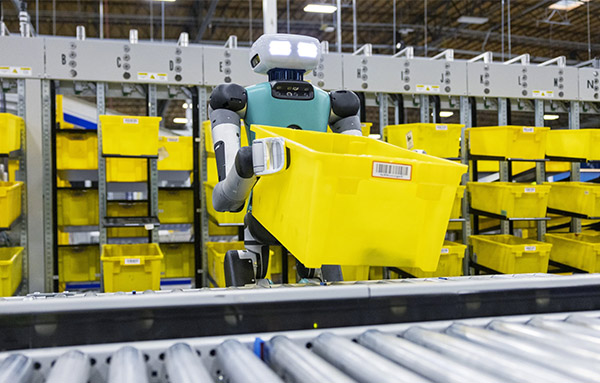
Amazon touts robots plus workers
Contrary to popular belief, Amazon said it believes that robots will create jobs rather than replace them.
“Ensuring robotics are collaborative and support employees is central to how we design or deploy systems like Sequoia and Digit,” said Dresser. “Over the last 10 years, we’ve rolled out hundreds of thousands of robotics systems while also creating hundreds of thousands of new jobs within our operations. This includes 700 categories of new job types, in skilled roles, which didn’t exist within the company beforehand.”
“By equipping our employees with new technology and training them to develop new skills, we’re creating career paths and new and exciting ways for people to contribute here at Amazon,” he wrote.
By developing robotics hardware and embedded artificial intelligence, Amazon claimed that it can make work safer, easier, and less repetitive. As a result, it said, employees will gain “the time and opportunity to take a step back, look at how orders are moving though our sites, and find new ways to delight and serve our customers.”
Article topics
Email Sign Up

